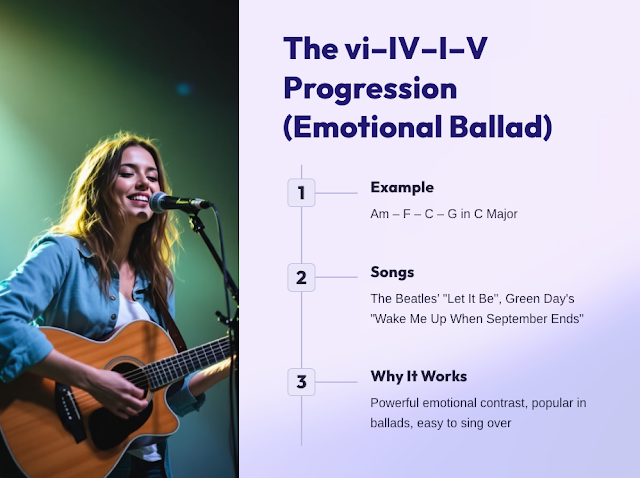🎶 Introduction: Why Chord Progressions Matter
If you’ve ever wondered why so many songs sound familiar, it’s because many of them use the same chord progressions. These patterns are the foundation of modern music, appearing in pop, rock, jazz, blues, and even classical pieces.
Understanding chord progressions is crucial for musicians, whether you’re playing an instrument, composing songs, or simply analyzing music. By learning a few essential progressions, you’ll be able to recognize popular songs, play along, and even create your own compositions more easily.
In this post, we’ll cover five of the most commonly used chord progressions in modern music. These progressions have shaped countless hit songs and are used in multiple genres. Whether you’re a beginner guitarist, a pianist, or a singer-songwriter, these patterns will help you improve your musical skills and understand the structure of great music.
🎵 1. The I–V–vi–IV Progression (The Pop Chord Progression)Example in C Major: C – G – Am – F
This is one of the most famous and widely used chord progressions in contemporary music. It has been used in countless pop hits, making it one of the most recognizable progressions of all time.
🎶 Songs That Use This Progression:
• Adele – “Someone Like You”
• Ed Sheeran – “Perfect”
• Journey – “Don’t Stop Believin’”
• Taylor Swift – “We Are Never Ever Getting Back Together”
🔹 Why This Progression Works:
✅ Catchy & Emotional: This progression creates an emotional connection with listeners, making it ideal for heartfelt pop songs.
✅ Versatile: It can be used in both upbeat and melancholic songs.
✅ Easy to Play: The chord shapes are beginner-friendly and appear frequently in guitar and piano tutorials.
This progression follows a strong harmonic movement, transitioning smoothly from major (I) to dominant (V), then to minor (vi), and resolving in the subdominant (IV). It gives a satisfying and familiar sound that is both uplifting and emotionally resonant.
🎸 2. The I–IV–V–I Progression (The Classic Rock Progression)
Example in C Major: C – F – G – C
This chord progression is the backbone of many rock, blues, and country songs. It has been a favorite among classic rock bands and early rock ‘n’ roll pioneers.
🎶 Songs That Use This Progression:
• Elvis Presley – “Hound Dog”
• Chuck Berry – “Johnny B. Goode”
• The Beatles – “Twist and Shout”
🔹 Why This Progression Works:
✅ Strong Resolution: The V chord creates a natural tension that resolves back to the I chord, making it sound complete.
✅ Great for Jamming: It’s an easy progression for improvisation and works well in blues and rock solos.
✅ Used Across Multiple Genres: You’ll find it in blues, country, rock, and even folk music.
If you’re looking to play classic rock and blues-style music, this is a must-know progression. The I–IV–V sequence creates a powerful, driving rhythm that works well for energetic, upbeat songs.
🎹 3. The vi–IV–I–V Progression (The Emotional Ballad Progression)
Example in C Major: Am – F – C – G
This progression is commonly found in sentimental, emotional, and inspirational songs. It has a melancholic feel at first (starting on the vi chord), but gradually builds into a hopeful and uplifting resolution.
🎶 Songs That Use This Progression:
• The Beatles – “Let It Be”
• Green Day – “Wake Me Up When September Ends”
• U2 – “With or Without You”
• Avicii – “Wake Me Up”
🔹 Why This Progression Works:
✅ Powerful Emotional Contrast: Moving from a minor chord (vi) to major chords (IV, I, V) creates a sense of tension and release.
✅ Popular in Ballads: Many love songs and heartfelt ballads use this progression.
✅ Easy to Sing Over: The gradual rise in chords makes it perfect for vocal-driven melodies.
This progression is commonly associated with songs that tell stories, which is why it is used in many acoustic ballads and pop anthems.
🎼 4. The 12-Bar Blues Progression (Blues & Jazz Classic)
Example in C Major:
C – C – C – C – F – F – C – C – G – F – C – G
The 12-bar blues progression is one of the most fundamental progressions in music. It originated in blues music but has influenced rock, jazz, and even pop.
🎶 Songs That Use This Progression:
• B.B. King – “The Thrill Is Gone”
• Muddy Waters – “Hoochie Coochie Man”
• Eric Clapton – “Before You Accuse Me”
🔹 Why This Progression Works:
✅ Groovy & Repetitive: Its simple repeating pattern creates a steady rhythm for solos and improvisation.
✅ Essential for Blues & Jazz Musicians: Most blues-based songs use this structure.
✅ Great for Beginners Learning the Blues: It helps you practice rhythm and phrasing.
If you’re interested in learning blues or jazz guitar, mastering the 12-bar blues progression is essential.
🎶 5. The ii–V–I Progression (The Jazz Standard)
Example in C Major: Dm7 – G7 – Cmaj7
This is the most important chord progression in jazz and appears in countless jazz standards. It has a sophisticated and harmonically rich sound.
🎶 Songs That Use This Progression:
• “Autumn Leaves”
• “Blue Bossa”
• “All The Things You Are”
🔹 Why This Progression Works:
✅ Creates a Smooth Movement: The ii–V–I sequence naturally leads back to the tonic chord.
✅ Essential for Jazz Improvisation: Many jazz solos are built around this progression.
✅ Used in Advanced Harmonic Structures: It’s common in modulations and chord substitutions.
If you’re planning to explore jazz, this is a must-learn progression.
🎧 Conclusion: How to Use These Chord Progressions
🎹 Now that you know these five essential chord progressions, here’s how to practice them:
✔ Try playing them in different keys.
✔ Listen to famous songs and recognize their progressions.
✔ Experiment with different rhythms and strumming patterns.
These chord progressions form the foundation of modern music, and mastering them will help you play, compose, and enjoy music even more!








Post a Comment